trailer PONTIAC GRAND-AM 1994 Owners Manual
[x] Cancel search | Manufacturer: PONTIAC, Model Year: 1994, Model line: GRAND-AM, Model: PONTIAC GRAND-AM 1994Pages: 274, PDF Size: 15.01 MB
Page 65 of 274
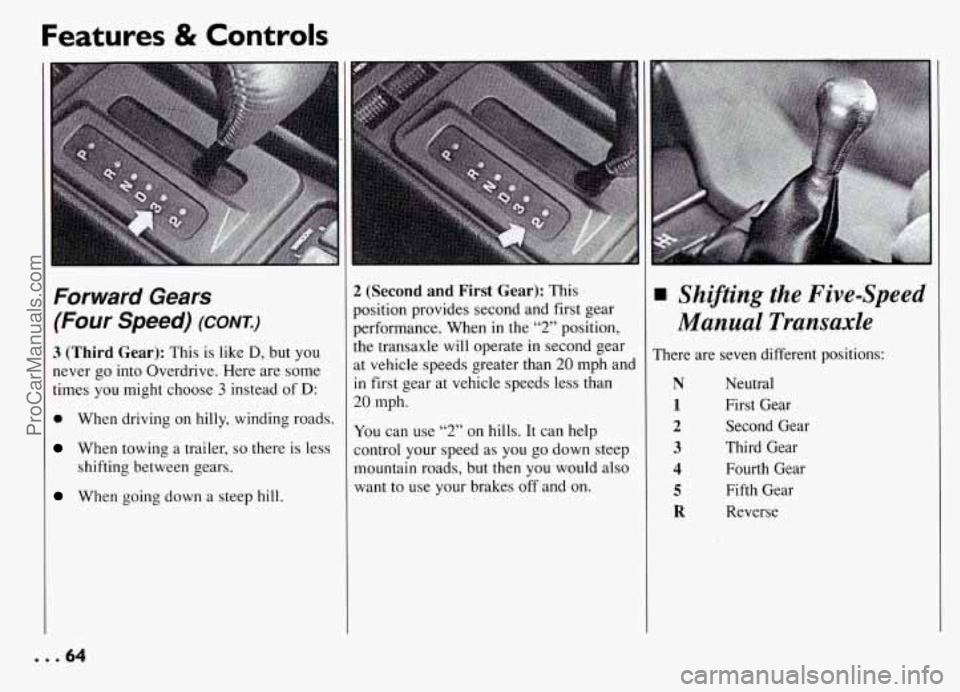
Features & Controls
Forward Gears
(Four Speed) (CONK)
3 (Third Gear): This is like D, but you
never
go into Overdrive. Here are some
times you might choose
3 instead of D:
0 When driving on hilly, winding roads.
When towing a trailer, so there is less
shifting between gears.
When going down a steep hill.
2 (Second and First Gear): This
position provides second and first gear
performance. When in the
“2” position,
the transaxle will operate in second gear
at vehicle speeds greater than
20 mph and
in first gear at vehicle speeds less than
20 mph.
You can use “2” on hills. It can help
control your speed as you go down steep
mountain roads, but then you would also
want to use your brakes
off and on.
Shifting the Five-Speed
Manual Transaxle
There are seven different positions:
N Neutral
1 First Gear
2 Second Gear
3 Third Gear
4 Fourth Gear
5 Fifth Gear
R Reverse
... 64
ProCarManuals.com
Page 68 of 274
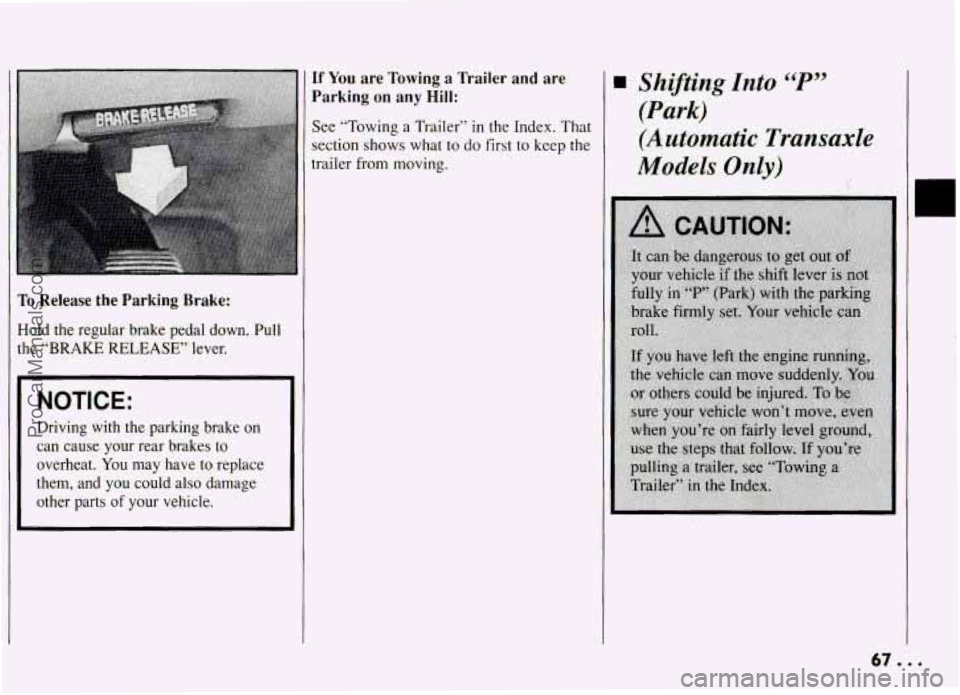
To Release the Parking Brake:
Hold the regular brake pedal down. Pull
the “BRAKE RELEASE” lever.
1 NOTICE:
Driving with the parking brake on
overheat. You may have to replace
them, and
you could also damage
other parts of
your vehicle. ~
can cause your rear brakes to
If You are
Towing a Trailer and are
Parking
on any Hill:
See “Towing a Trailer” in the Index. That
section shows what
to do first to keep the
trailer from moving.
Shifting Into “P”
(Park)
(Automatic Transaxle
Models
Only)
E
ProCarManuals.com
Page 70 of 274

H Shifting Out of
PARK (P)
(Automatic Transaxle
Models Only)
Your Pontiac has a brake-transaxle shift
interlock. You have to
fully apply your
regular brake before you can shift from
PARK
(P) when the ignition is in the
RUN position. See “Automatic
Transaxle”
in the Index.
tf you cannot shift out of PARK (P), ease
pressure on the shift lever
- push the
shift lever all the way into PARK (P) -as
you maintain brake application. Then
move the shift lever into the gear you
want. (Press the
shift lever button before
moving the shift lever.)
[f you ever hold the brake pedal down but
still can’t shift out of PARK (P), try this:
1. Turn the key to OFF.
2. Apply and hold the brake until the end
of Step 4.
3. Shift to NEUTRAL (N).
4. Start the vehicle and then shift to the
drive gear you want.
5. Have the vehicle fixed as soon as you
can.
Parking Your Vehicle
(Manual Transaxle
Models Only)
Before you get out of your vehicle, put
your manual transaxle
in REVERSE (R)
and firmly apply the parking brake.
If you are parking on a hill, or if your
vehicle is equipped to tow a trailer, see
“Towing a Trailer”
in the Index.
Parking Over Things
That Burn
ProCarManuals.com
Page 72 of 274
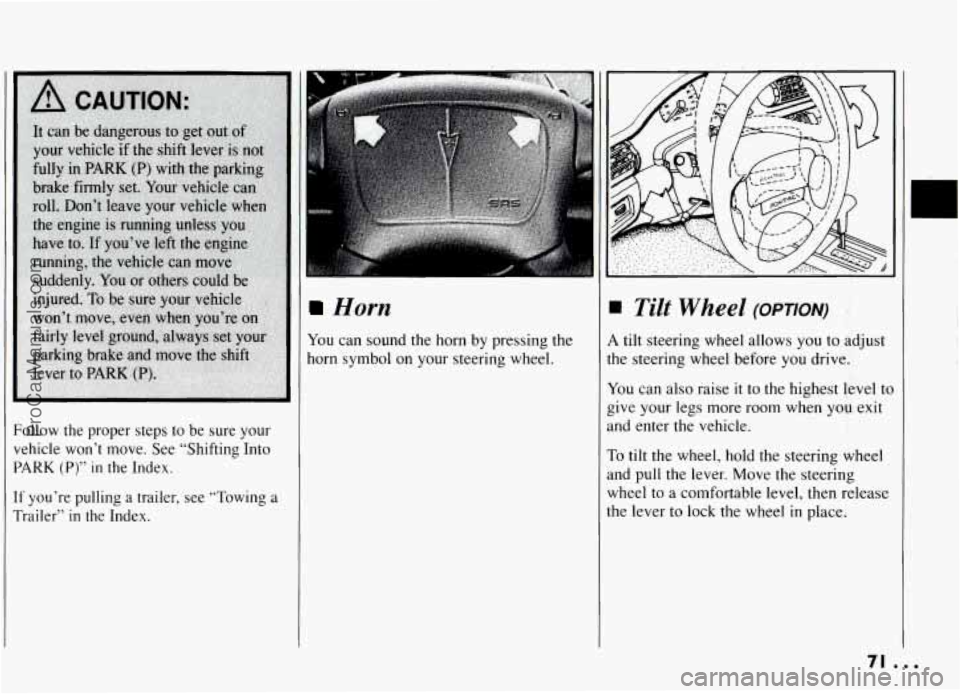
Follow the proper steps to be sure your
vehicle won’t move. See “Shifting Into
PARK (P)” in the Index.
If you’re pulling a trailer, see “Towing a
Trailer”
in the Index.
Horn
You can sound the horn by pressing the
horn symbol
on your steering wheel.
A tilt steering wheel allows you to adjust
the steering wheel before you drive.
You can also raise it to the highest level tc
give your legs more room when you exit
and enter the vehicle.
To tilt the wheel, hold the steering wheel
and pull the lever. Move the steering
wheel to a comfortable level, then release
the lever
to lock the wheel in place,
71 ...
ProCarManuals.com
Page 142 of 274

Towing a Trailer
NOTICE:
Pulling a trailer improperly can
damage your vehicle and result
in
costly repairs not covered by your
warranty. To pull
a trailer correctly,
follow the advice
in this section, and
see your Pontiac dealer for important information about towing
a trailer
with your vehicle .
Do not tow a trailer if your vehicle is
equipped with the 2.3L OHC or Quad 4
Engine (Code 3 or D).
Your car can tow a trailer if it is equipped
with the
2.3L High Output Quad 4 (Code
A) or 3.1 L V6 (Code M) engine and
proper trailer towing equipment. To
identify what the vehicle trailering
capacity is for your vehicle, you should
read the information
in ‘‘Weight of the
Trailer” that appears later
in this section.
But trailering is different than just driving
your vehicle by itself. Trailering means
changes
in handling, durability, and fuel
economy. Successful, safe trailering takes
correct equipment, and
it has to be used
properly.
That’s the reason for this section. In it are
many time-tested, important trailering
tips and safety rules. Many of these are
important for your safety and that of your
passengers.
So please read this section
carefully before you puli a trailer.
Load-pulling components such as the
mgine, transaxle, wheel assemblies, and
tires are forced
to work harder against the
jrag of the added weight. The engine is
required to operate at relatively higher
speeds and under greater loads,
generating extra heat. What’s more, the
trailer adds considerably to wind
resistance, increasing the pulling
requirements.
If You Do Decide To Pull A Trailer
If you do, here are some important points.
0 There are many different laws,
including speed limit restrictions,
having to do with trailering. Make
sure your rig will be legal, not only
where you live but also where you’ll
be driving.
A good source for this
information can be state or provincial
police.
0 Consider using a sway control.
You can ask a hitch dealer about sway
controls.
Don’t tow a trailer at all during the
first 1000 miles (1 600 km) your new
vehicle is driven. Your engine, axle or
other parts could be damaged.
Then, during the first 500 miles (800
km) that you tow a trailer, don’t drive
over
50 mph (80 km/h) and don’t
make starts
at full throttle. This helps
141
ProCarManuals.com
Page 143 of 274
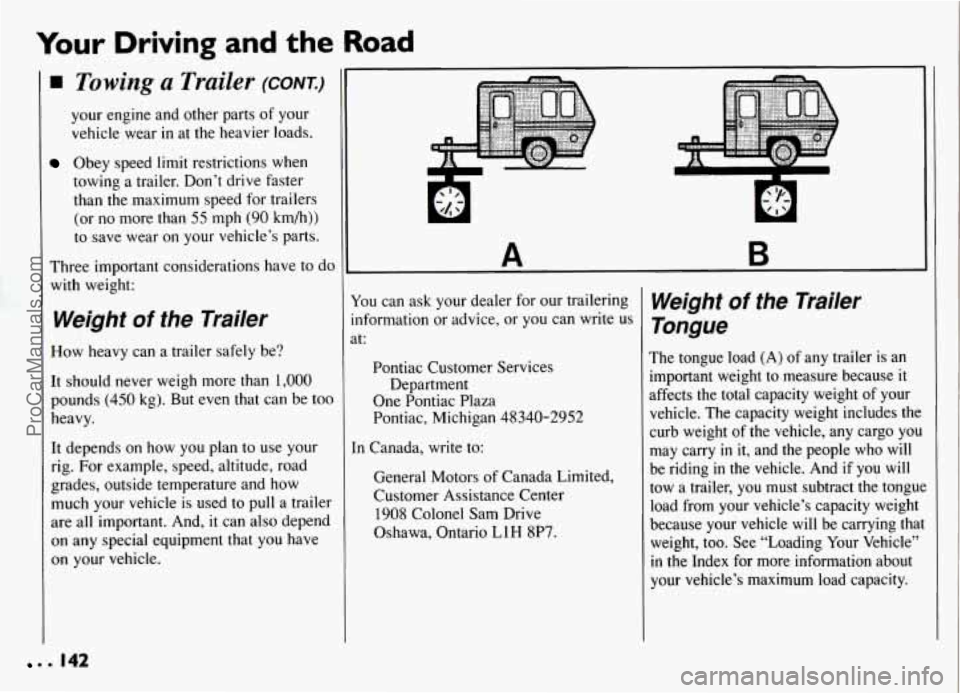
Your Driving and the Road
Towing a Trailer (CONK)
your engine and other parts of your
vehicle wear
in at the heavier loads.
Obey speed limit restrictions when
towing a trailer. Don’t drive faster
than the maximum speed for trailers
(or no more than
55 mph (90 km/h))
to save wear on your vehicle’s parts.
Three important considerations have to do
with weight:
Weight of the Trailer
How heavy can a trailer safely be?
It should never weigh more than 1,000
pounds (450 kg). But even that can be too
heavy.
It depends on how you plan to use your
rig. For example, speed, altitude, road
grades, outside temperature and how
much your vehicle is used to pull a trailer
are all important. And,
it can also depend
on any special equipment that you have
on your vehicle.
A B
fou can ask your dealer for our trailering
nformation or advice, or you can write
us
It:
Pontiac Customer Services
Department
One Pontiac Plaza
Pontiac, Michigan 48340-2952
[n Canada, write to:
General Motors of Canada Limited,
Customer Assistance Center
1908 Colonel Sam Drive
Oshawa, Ontario L1H 8P7.
Weight of the Trailer
Tongue
The tongue load (A) of any trailer is an
important weight to measure because
it
affects the total capacity weight of your
vehicle. The capacity weight includes the
curb weight of the vehicle, any cargo you
may carry
in it, and the people who will
be riding in the vehicle. And if you will
tow a trailer, you must subtract the tongu
load from your vehicle’s capacity weight
because your vehicle
will be carrying tha
weight, too. See “Loading Your Vehicle”
in the Index for more information about
your vehicle’s maximum load capacity.
. . 142
ProCarManuals.com
Page 144 of 274

If you’re using a “dead-weight” hitch, the
trailer tongue
(A) should weigh 10% of
the total loaded trailer weight (B). If you
have
a “weight-distributing” hitch, the
trailer tongue
(A) should weigh 12% of
the total loaded trailer weight
(B).
After you’ve loaded your trailer, weigh
the trailer and then the tongue, separately, to see if the weights are proper. If they
aren’t, you may
be able to get them right
simply by moving some items around in
the trailer.
Total Weight on Your
Vehicle’s Tires
Be sure your vehicle’s tires are inflated to
the limit for cold tires. You’ll find these
numbers on the Certification label at the
rear edge of the driver’s door or see
“Loading Your Vehicle”
in the Index.
Then be sure you don’t go over the GVW
limit for your vehicle.
Hitches
It’s important to have the correct hitch
equipment. Crosswinds, large trucks
going by, and rough roads are a few
reasons
why you’ll need the right hitch.
Here are some rules to follow:
Will you have to make any holes in
the body
of your vehicle when you
install a trailer hitch? If
you do, then
be sure to seal the holes later when
you remove the hitch. If you don’t
seal them, deadly carbon monoxide
(CO) from your exhaust can get into
your vehicle (see “Carbon Monoxide”
in the Index). Dirt and water can, too.
The bumpers on your vehicle are
not
intended for hitches. Do not attach
rental hitches or other bumper-type hitches to them. Use only a
frame-mounted hitch that does not
attach to the bumper.
Sa#ety Chains
You should always attach chains between
your vehicle
and your trailer. Cross the
safety chains under the tongue of the
trailer
so that the tongue will not drop to
the road if it becomes separated from the
hitch. Instructions about safety chains may be provided by the hitch
manufacturer or by the trailer
manufacturer. Follow the manufacturer’s
recommendation for attaching safety chains. Always leave just enough slack
so
you can turn with your rig. And, never
allow safety chains to drag on the .ground.
Trailer Brakes
Does your trailer have its own brakes?
Be sure to read and follow the instructions
for the trailer brakes
so you’ll be able to
install, adjust and maintain them properly.
And because you have anti-lock brakes,
do not try to tap into your vehicle’s brake
system. If you do, both brake systems
won’t work well, or at all.
0
!
1
I I
!
143...
ProCarManuals.com
Page 145 of 274

Your Driving and the Road
I Driving with a Trailer
Towing a trailer requires a certain amount
of experience. Before setting out for the
open road, you’ll want to get to know
your rig. Acquaint yourself with the feel
of handling and braking with the added
weight
of the trailer. And always keep in
mind that the vehicle you are driving is
now a good deal longer and not nearly
so
.responsive as your vehicle is by itself.
Before you start, check the trailer hitch
and platform, safety chains, electrical
connector, lights, tires and mirror
adjustment. If the trailer has electric
brakes, start your vehicle and trailer
moving and then apply the trailer brake
controller by hand to be sure the brakes
are working. This lets you check your
electrical connection at the same time.
During your trip, check occasionally to be
sure that the load is secure, and that the
lights and any trailer brakes are still
working.
Following Distance
Stay at least twice as far behind the
vehicle ahead as you would when driving
your vehicle without a trailer. This can
help you avoid situations that require
heavy braking and sudden turns.
Passing
You’ll need more passing distance up
ahead when you’re towing a trailer. And,
because you’re a good deal longer, you’ll
need to go much farther beyond the
passed vehicle before you can return to
your lane.
Backing Up
Hold the bottom of the steering wheel
with one hand. Then, to move the trailer
to the left, just move that hand to the left.
To move the trailer to the right, move
your hand to the right. Always back up
slowly and,
if possible, have someone
guide you.
Making Turns
When you’re turning with a trailer, make
wider turns than normal. Do this
so your
railer won’t strike soft shoulders, curbs,
road signs, trees, or other objects. Avoid
ierky or sudden maneuvers. Signal well
in
3dvance.
Turn Signals When
Towing
a Trailer
When you tow a trailer, your vehicle has
to have a different turn signal flasher and
extra wiring. The green arrows on your
instrument panel will flash whenever you
signal a
turn or lane change. Properly
hooked up, the trailer lights will also
flash, telling other drivers you’re about to
turn, change lanes or stop.
When towing a trailer, the green arrows
on your instrument panel will flash for
turns even
if the bulbs on the trailer are
burned out. Thus, you may
think drivers
behind you are seeing your signal when
they are not. It’s important to check
occasionally to be sure the trailer bulbs
are still working.
. . . 144
ProCarManuals.com
Page 146 of 274
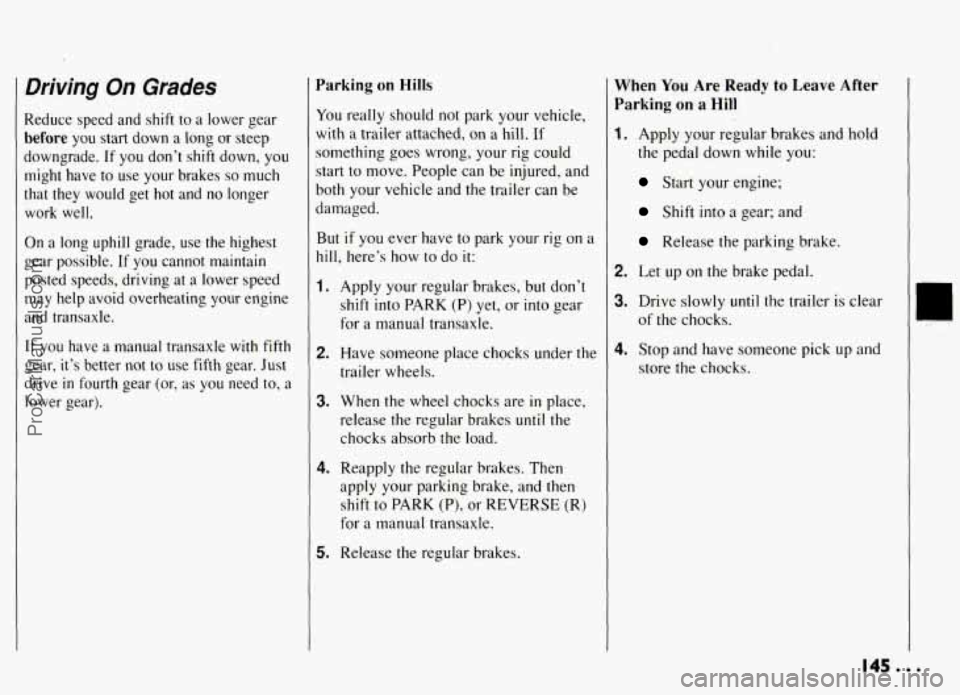
1 Driving On Grades
Reduce speed and shift to a lower gear
before you start down a long or steep
downgrade. If you don’t shift down,
you
might have to use your brakes so much
that they would get hot and no longer
work well.
On a long uphill grade, use the highest
gear possible. If you cannot maintain
posted speeds, driving at a lower speed
may help avoid overheating your engine
and transaxle.
If you have a manual transaxle with fifth
gear, it’s better not to use fifth gear. Just
drive
in fourth gear (or, as you need to, a
lower gear).
Parking on Hills
You really should not park your vehicle,
with a trailer attached, on
a hill. If
something goes wrong, your rig could
start to move. People can be injured, and
both your vehicle and the trailer can be
damaged.
But if you ever have to park your rig on a
hill, here’s how to do it:
1. Apply your regular‘brakes, but don’t
shift into PARK (P) yet, or into gear
for a manual transaxle.
2. Have someone place chocks under the
trailer wheels.
3. When the wheel chocks are in place,
release the regular brakes
until the
chocks absorb the load.
4. Reapply the regular brakes. Then
apply your parking brake, and then
shift to PARK
(P), or REVERSE (R)
for a manual transaxle.
5. Release the regular brakes.
When You Are Ready to Leave After
Parking
on a Hill
1. Apply your regular brakes and hold
the pedal down while you:
Start your engine;
Shift into a gear; and
Release the parking brake.
2. Let up on the brake pedal.
3. Drive slowly until the trailer is clear
of the chocks.
4. Stop and have someone pick up and
store the chocks.
145...
ProCarManuals.com
Page 147 of 274

Your Driving and the Road
Maintenance When Trailer
Towing
Your vehicle will need service more often
when you’re pulling a trailer. See the
Maintenance Schedule for more on this.
Things that are especially important in
trailer operation are automatic transaxle
fluid (don’t overfill), engine oil, belts,
cooling system, and brake adjustment.
Each of these is co%ered in this manual,
and the Index will help you find them
quickly. If you’re trailering, it’s a good
idea to review these sections before
you
start your .trip.
Check periodically to see that all hitch
b e 146
ProCarManuals.com